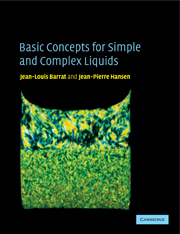4 - Mean field approaches
Published online by Cambridge University Press: 06 January 2010
Summary
Lattice models and mean field treatment
Changes in temperature, pressure or chemical composition can lead to continuous or discontinuous phase changes, as illustrated schematically in figure 1.1. Phase transitions are ubiquitous in simple and complex fluids, and the thermodynamic conditions for phase equilibria have been spelled out in section 2.3. The most common phase transitions, like vapour condensation, freezing or the isotropic to nematic transition in liquid crystals, are first-order transitions, characterized by discontinuities of first derivatives of the free energy, like the entropy or the molar volume. Two (or more phases) can coexist over a range of temperatures or pressures and metastable thermodynamic states of one phase can exist for appreciable times under conditions where another phase has a lower free energy. Most first-order transitions can be reasonably well described within mean field theory, which is the leitmotiv of the present chapter. A key quantity in the description of first-order transitions is the order parameter, which generally characterizes some broken symmetry, taking a finite value in the phase of lower symmetry, and vanishing discontinuously at the transition towards the phase of higher symmetry. In many cases the order parameter can be associated with some microscopic variable, like the orientation vector of mesogenic molecules, but in the case of a transition between two isotropic fluids, with full rotational and translational invariance, like a liquid and its coexisting vapour, or two liquid mixtures of different compositions, the order parameter is a macroscopic characteristic, conveniently chosen to be the difference in density or concentration between the two phases.
- Type
- Chapter
- Information
- Basic Concepts for Simple and Complex Liquids , pp. 107 - 142Publisher: Cambridge University PressPrint publication year: 2003



